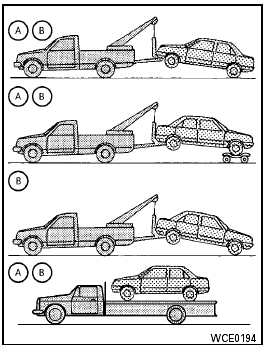Towing your vehicle
When towing your vehicle, all State (Provincial in Canada) and local regulations for towing must be followed. Incorrect towing equipment could damage your vehicle. Towing instructions are available from a NISSAN dealer. Local service operators are generally familiar with the applicable laws and procedures for towing. To assure proper towing and to prevent accidental damage to your vehicle, NISSAN recommends having a service operator tow your vehicle. It is advisable to have the service operator carefully read the following precautions:

● Never ride in a vehicle that is being towed.
● Never get under your vehicle after it has been lifted by a tow truck.

● When towing, make sure that the transmission, axles, steering system and powertrain are in working condition. If any of these conditions apply, dollies or a flatbed tow truck must be used.
● Always attach safety chains before towing.
For information about towing your vehicle behind a recreational vehicle (RV), refer to “Flat towing” in the “Technical and consumer information” section of this manual.

A (CVT) Continuously Variable Transmission
B (M/T) Manual transmission
See also:
Avoiding collision and rollover
WARNING:
Failure to operate this vehicle in a safe
and prudent manner may result in loss of
control or an accident.
Be alert and drive defensively at all times. Obey
all traffic regulations. A ...
Trip computer
To operate the trip computer, use the A
switch.
When the ignition switch is in the ON position,
modes of the trip computer can be selected by
pushing the switch A briefly.
Each time the ...
Supplemental air bag warning light
The supplemental air bag warning light, displaying
in the instrument panel, monitors the
circuits of the supplemental front-impact air bag,
front seat-mounted side-impact supplemental
air ...
